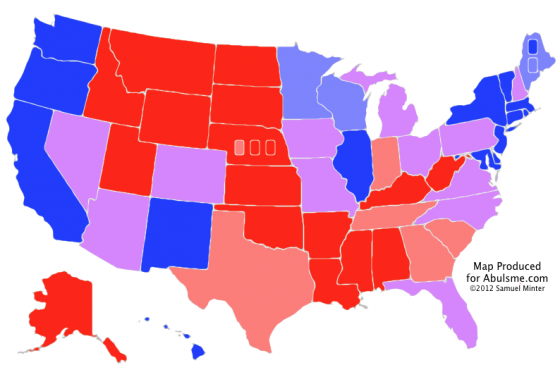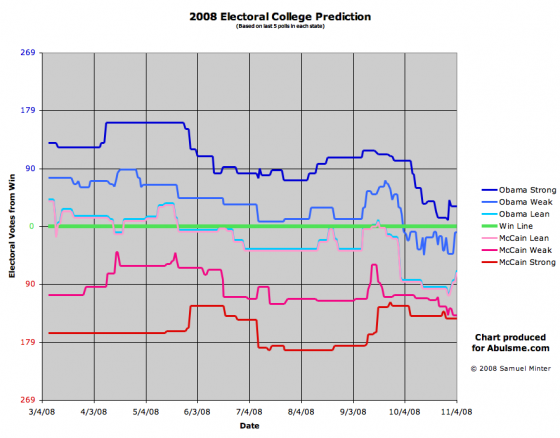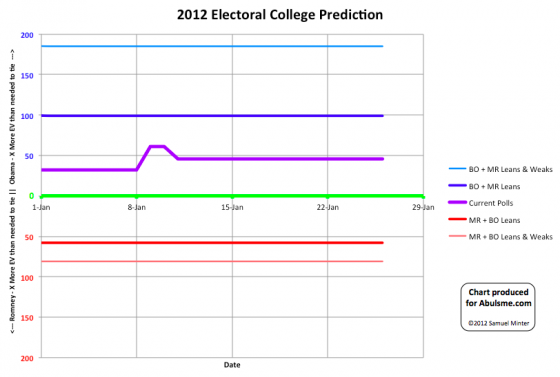Map from the Abulsme.com 2012 Electoral College Prediction page.
Well, the time has come. I have put together my initial general election forecast. Now, since so far Romney has been the only one in the lead in my Republican Delegate Count Tracking this initial analysis is based on the assumption that this will be an Obama vs Romney race. If someone else, say, I don’t know, Gingrich, would take a lead in my delegate count at some point in the future, I’ll produce a new analysis based on that pairing. For now though, we assume a Romney nomination.
Bottom line at the moment… Obama is in a better position than Romney. If everybody won the states where my polling average indicates they are even slightly ahead, Obama wins by 315 to 223. But there are 12 states that at the moment should be considered too close to call. If Romney were to win all 12 of those states, he would win 327 to 211. If Obama were to win all 12 of those states, he would win 368 to 170. (For reference, 2008’s final result was Obama 365, McCain 173, so at the moment Obama’s best case is just slightly better than his 2008 result.)
For details on the methodology I am using, please see the full 2012 Electoral College Prediction page. It isn’t the most sophisticated analysis method out there, others such as HorsesAss.org are doing more complex things such as Monte Carlo simulations based on current polling, etc. As we get closer to November, there will be dozens of sites doing different sorts of modeling and predicting possible results in different ways. I hope mine provides a slightly different view which is useful or interesting to at least a few people.
The main item that is different with what I show than what I’ve seen other places is my method of showing the evolving race over time. In 2008, that chart ended up looking like this:
(More on the 2008 analysis can be found at the 2008 Electoral College Prediction page.)
In the 2008 chart above, the lower the lines were, the better off Obama was doing, the higher the lines, the better off McCain was. The nice thing here though is you can see the ebb and flow of the race over the course of the year. So you can tell McCain was doing well in the Spring, then sometime in May he was no longer the favorite to win, and with the exception of a few days right around the Republican convention, he was never ahead again. Then soon after the conventions were all over, McCain just collapsed and by the time we got to October, it was clear that it would take something remarkable happening for him to pull off a win.
Anyway, for 2012 I’ve redone some of the details of how this chart is constructed, hopefully improving readability and intuitiveness. We don’t have all that much data or action yet so far, things are just beginning after all, but here it is:
Chart from the Abulsme.com 2012 Electoral College Prediction page.
This time up is better for Obama, down is better for Romney.
The two wobbles on the center line so far are Florida flipping from Leaning Romney to Leaning Obama on January 9th, and North Carolina flipping from Leaning Obama to Leaning Romney on January 12th.
Since this is the first post of the year for this model, I’ll include here the full explanation of how to interpret this chart:
First of all, the current state of the race for each state (or congressional districts as well in the cases of Maine and Nebraska) is determined by looking at the average margin between the candidates in the last five polls in that area. In cases where five polls are not yet available, the final popular vote results in the 2004 and 2008 elections were used to “seed” the data.
States are then put into 3 categories.
- Lean: 0% ≤ Candidate Lead < 5%
- Weak: 5% ≤ Candidate Lead < 10%
- Strong: Candidate Lead ≥ 10%
All “lean” states are for all intents and purposes too close to call, but for the chart above, we separate them.
The chart is divided into two halves.
- Above the green line, the Democrat is winning with X more electoral votes than they need to tie. (So 269+X = their electoral vote total)
- Below the green line, the Republican is winning with X more electoral votes than they need to tie. (So 269+X = their electoral vote total)
We show five lines, outlining five different scenarios showing the range of possibilities given the current polling.
- Light Blue Line – The Democrat wins all states they are ahead in, but also flips the Republican’s Lean and Weak states.
- Dark Blue Line – The Democrat wins all states they are ahead in, but also flips the Republican’s Lean states.
- Purple Line – Each candidate wins the states they are ahead in, no states flip.
- Dark Red Line – The Republican wins all states they are ahead in, but also flips the Democrat’s Lean states.
- Light Red Line – The Republican wins all states they are ahead in, but also flips the Democrats Lean and Weak states.
We assume that states where a candidate is “Strong” have essentially no chance of flipping.
The light lines would represent a very unlikely sweep with a candiate massively exceeding what polling would indicate in a large number of states at the same time.
But “Lean” states are essentially all too close to call, in that a 5% lead is small enough that it can easily be affected by natural random variations in polls, or even excluding those sorts of effects, a 5% move in opinion is easily possible in just a few days given particularly effective campaigning by one candidate, or a particularly bad gaffe by the other, or simply by the effects of the news cycle. So essentially anything between the dark blue and dark red lines should be considered to be quite possible given the current state of polling, although of course results closer to the purple line (representing the actual current state of polling) are more likely than results close to the dark red or dark blue lines.
Edit 2012 May 30 15:53 UTC – Since this was posted, I was made aware of more older polls that should have resulted in New Hampshire starting off as a “Weak Romney” state instead of a “Lean Romney” state. The time series charts are corrected as of May 30. Further details of the New Hampshire correction are also located in that post.



The National Popular Vote bill would guarantee the Presidency to the candidate who receives the most popular votes in all 50 states (and DC).
Every vote, everywhere, would be politically relevant and equal in presidential elections. No more distorting and divisive red and blue state maps. There would no longer be a handful of ‘battleground’ states where voters and policies are more important than those of the voters in more than 3/4ths of the states that now are just ‘spectators’ and ignored.
When the bill is enacted by states possessing a majority of the electoral votes– enough electoral votes to elect a President (270 of 538), all the electoral votes from the enacting states would be awarded to the presidential candidate who receives the most popular votes in all 50 states and DC.
The bill uses the power given to each state by the Founding Fathers in the Constitution to change how they award their electoral votes for President. Historically, virtually all of the major changes in the method of electing the President, including ending the requirement that only men who owned substantial property could vote and 48 current state-by-state winner-take-all laws, have come about by state legislative action.
In Gallup polls since 1944, only about 20% of the public has supported the current system of awarding all of a state’s electoral votes to the presidential candidate who receives the most votes in each separate state (with about 70% opposed and about 10% undecided). Support for a national popular vote is strong among Republicans, Democrats, and Independent voters, as well as every demographic group in virtually every state surveyed in recent polls in closely divided Battleground states: CO – 68%, FL – 78%, IA 75%, MI – 73%, MO – 70%, NH – 69%, NV – 72%, NM– 76%, NC – 74%, OH – 70%, PA – 78%, VA – 74%, and WI – 71%; in Small states (3 to 5 electoral votes): AK – 70%, DC – 76%, DE – 75%, ID – 77%, ME – 77%, MT – 72%, NE 74%, NH – 69%, NV – 72%, NM – 76%, OK – 81%, RI – 74%, SD – 71%, UT – 70%, VT – 75%, WV – 81%, and WY – 69%; in Southern and Border states: AR – 80%,, KY- 80%, MS – 77%, MO – 70%, NC – 74%, OK – 81%, SC – 71%, TN – 83%, VA – 74%, and WV – 81%; and in other states polled: CA – 70%, CT – 74%, MA – 73%, MN – 75%, NY – 79%, OR – 76%, and WA – 77%. Americans believe that the candidate who receives the most votes should win.
The bill has passed 31 state legislative chambers in 21 small, medium-small, medium, and large states. The bill has been enacted by 9 jurisdictions possessing 132 electoral votes – 49% of the 270 necessary to bring the law into effect.
NationalPopularVote
Follow National Popular Vote on Facebook via nationalpopularvoteinc
The comment is kind of link-spammy, but I let it through anyway, as it is relevant.
Personally, I think it would be a tragedy if we eliminated the electoral college and went to a system that essentially ratified the popular vote. The electoral college was designed for very good reasons that remain true today regarding preventing the large population centers from dominating the political conversation.